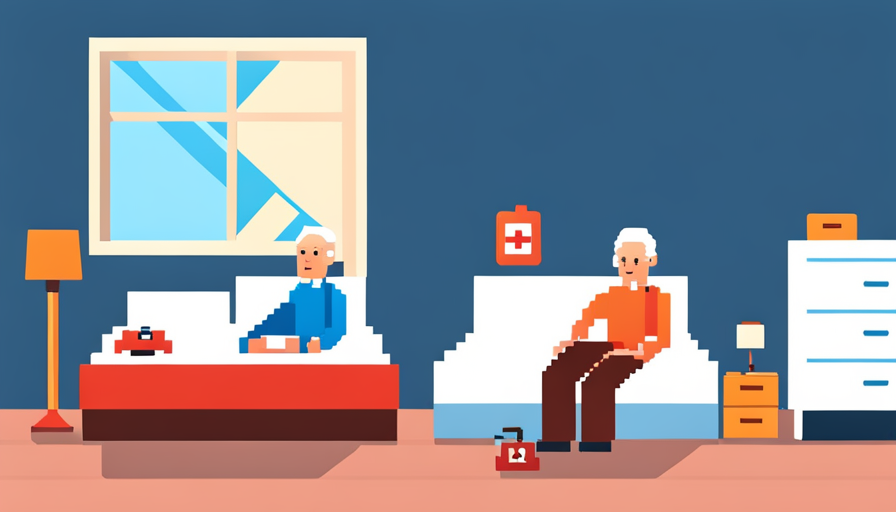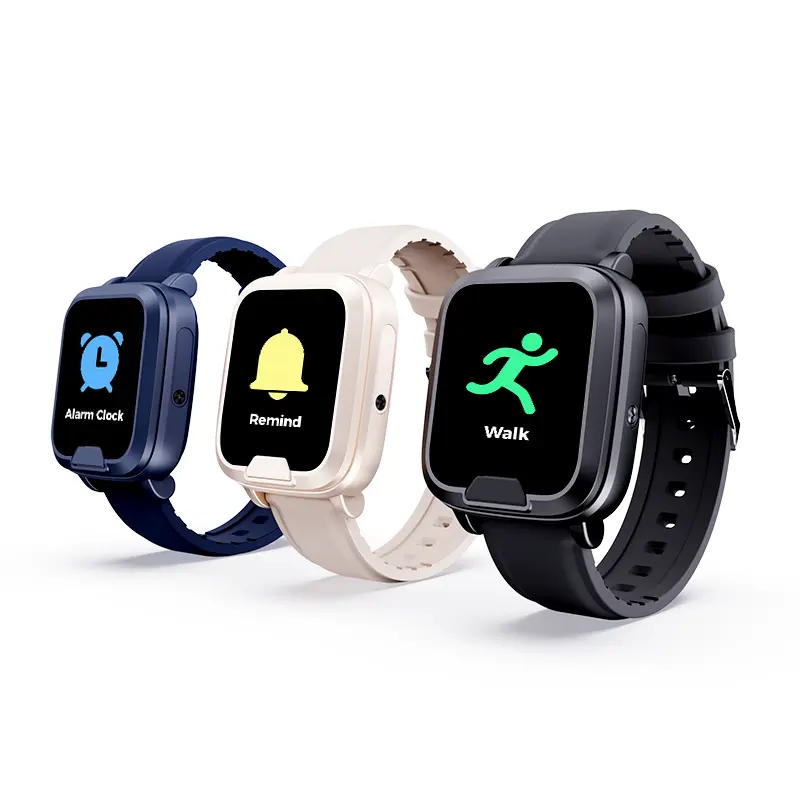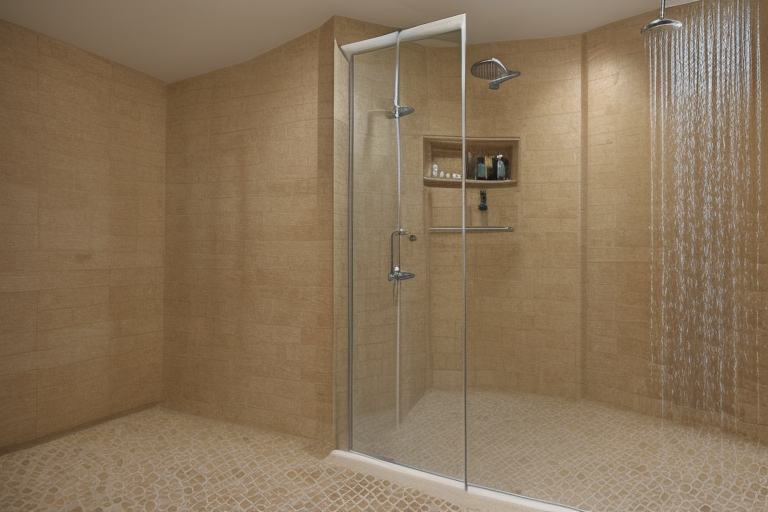Introduction to wireless call button systems in home care
The world of home care is evolving at a rapid pace, with new technologies and innovations making it easier than ever for individuals to receive the support and assistance they need in the comfort of their own homes. One such advancement in the field of home care is the introduction of wireless call button systems. These devices provide an unparalleled level of convenience, allowing patients and their caregivers to communicate effectively and efficiently, even when they are in different parts of the house.
Wireless call button systems are designed to be user-friendly and highly reliable, ensuring that individuals in need of assistance can quickly and easily get the help they require. They are also highly versatile, with a wide range of options available to suit the specific needs and preferences of each user. Whether they are elderly individuals seeking a greater level of independence, people living with disabilities who require ongoing support, or those recovering from surgery or illness, wireless call buttons can make a significant difference in the quality of life for those who use them.
In this article, we will explore the importance of call buttons in home care, discuss the various types of wireless call button systems available on the market, highlight the key features of an effective system, compare popular models, and provide guidance on choosing the right device for your needs. By the end of this comprehensive guide, you will have a deeper understanding of the power and convenience that these innovative tools can bring to the world of home care.
The importance of call buttons in home care
Call buttons play a crucial role in delivering efficient and effective home care services. They provide a direct line of communication between patients and their caregivers, allowing for immediate assistance and support when required. This not only increases the level of safety, security, and peace of mind for individuals receiving care, but it also enables caregivers to provide more responsive, personalized support.
In addition to enhancing communication, call buttons can also improve the overall quality of care by enabling patients to maintain a greater level of independence. With the ability to call for help when needed, individuals can feel more confident in their ability to manage their own needs and participate in daily activities. This can have a significant impact on overall well-being and satisfaction with the care received.
Furthermore, call buttons can also benefit caregivers, as they allow for more efficient use of time and resources. By enabling patients to communicate their needs directly, caregivers can focus on providing assistance when it is truly required, rather than constantly checking in or monitoring their patients. This can lead to a more sustainable and satisfying work environment for care professionals.
Types of wireless call button systems
There are several different types of wireless call button systems available on the market, each with their own unique features and benefits. Some of the most common types include:
- Wristband alarm transmitters: These devices are worn like a watch and allow users to call for help by simply pressing a button on the wristband. They are often waterproof and can be worn at all times, making them ideal for individuals who may require assistance while bathing or engaging in other water-based activities.
- SOS buttons: These portable devices can be carried in a pocket, worn on a lanyard, or mounted on a wall, providing users with a convenient and accessible means of calling for help when needed. They are typically battery-powered and can be easily moved between locations as required.
- Pendant to pager kits: These systems consist of a pendant worn around the neck and a pager unit carried by the caregiver. When the button on the pendant is pressed, a signal is sent to the pager, alerting the caregiver that assistance is needed.
- Call point to pager kits: Similar to pendant to pager kits, these systems involve a wall-mounted call point that sends a signal to a pager unit when activated. They are particularly useful in larger homes or care facilities where multiple call points may be needed.
- Hospital in the home range: These more advanced systems are designed to replicate the functionality of a hospital nurse call system within a home setting. They often include multiple call points, pagers, and additional features such as bed exit alarms and fall detection sensors.
Key features of an effective wireless call button system
When evaluating the various wireless call button systems on the market, there are several key features that you should look for in order to ensure that you select the most effective and reliable option for your needs. Some of these essential features include:
- Ease of use: The best wireless call button systems will be simple and intuitive to use, with large, clearly marked buttons that are easy to press, even for individuals with limited dexterity or mobility.
- Range: The system should have a sufficient range to ensure that signals can be transmitted from anywhere within the home or care facility, without the risk of dropped or missed calls.
- Durability: The device should be built to withstand daily use, including potential drops or exposure to water (particularly if it is intended to be used during bathing or other water-based activities).
- Battery life: The system should have a long battery life to minimize the need for frequent charging or replacement, ensuring that it is always ready for use when needed.
- Compatibility: The device should be compatible with other nurse call systems or devices that may be in use within the home or care facility, allowing for seamless integration and communication between all parts of the care network.
Comparing popular wireless call button systems
In order to help you make an informed decision when selecting a wireless call button system for your home care needs, we have compared some of the most popular and highly rated options on the market:
Cura1 wristband alarm transmitter
- Waterproof and comfortable to wear
- Easy to press button
- Long battery life
- Compatible with various nurse call systems
- Wide range of signal transmission
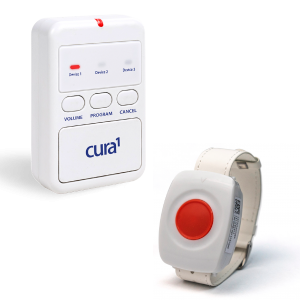
Cura1 SOS button
- Portable and easy to use
- Battery-powered for convenience
- Compatible with various nurse call systems
- Wide range of signal transmission
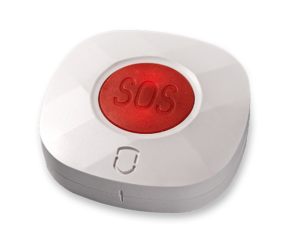
Safe-Life pendant to pager kit
- Simple and intuitive design
- Lightweight pendant for comfortable wear
- Long battery life
- Wide range of signal transmission
- Requires minimal installation
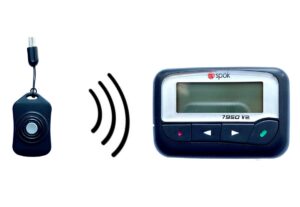
Safe-Life Call point to pager kit
- Wall-mounted call point for easy access
- Wide range of signal transmission
- Compatible with various nurse call systems
- Requires minimal installation
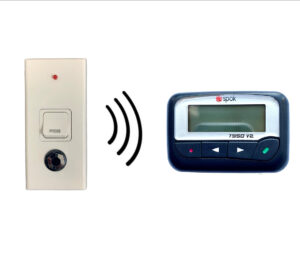
Safe-Life hospital in the home range
- Comprehensive system replicating hospital nurse call functionality
- Multiple call points and pagers for larger homes or care facilities
- Additional features such as bed exit alarms and fall detection sensors
- Compatible with various nurse call systems
Cura1 personal emergency transmitter
- Portable and easy to use
- Waterproof for use in wet environments
- Wide range of signal transmission
- Compatible with various nurse call systems
Benefits of wireless call buttons for elderly care
Wireless call buttons are particularly beneficial for elderly individuals who may require assistance with various aspects of daily life, such as getting in and out of bed or using the bathroom. These devices offer several key advantages for users and their caregivers, including:
- Increased independence: By providing a simple, accessible means of calling for help when needed, wireless call buttons can enable elderly individuals to maintain a greater level of independence and control over their own lives.
- Enhanced safety and security: Knowing that help is just a button press away can provide peace of mind for both elderly individuals and their loved ones, reducing the risk of falls or other accidents.
- Improved communication: Wireless call buttons facilitate more effective communication between elderly individuals and their caregivers, ensuring that assistance is provided promptly and efficiently.
- Reduced caregiver stress: By allowing elderly individuals to call for help when needed, wireless call buttons can help to alleviate some of the pressure and stress often experienced by caregivers, enabling them to focus on providing the best possible care.
Integrating wireless call button systems with nurse call systems
In many cases, it may be necessary or desirable to integrate a wireless call button system with an existing nurse call system, particularly in larger care facilities or homes where multiple caregivers may be present. This can help to ensure that all care providers are notified when assistance is required, and can also allow for more detailed monitoring and record-keeping of patient needs and assistance requests.
When selecting a wireless call button system, be sure to choose one that is compatible with your existing nurse call system, and consider working with a professional installer or technician to ensure that the integration process goes smoothly and effectively.
How to choose the right wireless call button system for your home
With so many options available on the market, it can be challenging to determine which wireless call button system is the best choice for your specific needs. To help guide your decision-making process, consider the following factors:
- User needs: Think about the specific needs and preferences of the individual who will be using the call button, such as their level of mobility, dexterity, and cognitive function. This will help you to select a device that is easy for them to use and meets their unique requirements.
- Environment: Consider the size and layout of the home or care facility where the call button system will be used, as this will impact the range and type of device required.
- Budget: Wireless call button systems can vary widely in price, so it’s important to establish a budget for your purchase and choose a device that offers the best value for your money.
- Compatibility: If you already have a nurse call system in place, be sure to select a wireless call button system that is compatible with your existing setup.
Installation and maintenance of wireless call button systems
Once you have selected the right wireless call button system for your needs, it’s important to ensure that it is properly installed and maintained to ensure optimal performance and reliability. Some tips for installation and maintenance include:
- Read the user manual: Before attempting to install or use your new call button system, take the time to read through the user manual to familiarize yourself with its features and functions.
- Choose the right location: Consider where the call button will be most easily accessible and visible, and ensure that it is installed in a location that is easy for the user to reach.
- Test the signal: Before relying on the call button for emergency assistance, test the signal strength and range to ensure that it is working properly and can transmit signals to the caregiver.
- Replace batteries as needed: Most wireless call button systems require batteries for operation, so be sure to monitor the battery life and replace them as needed to ensure that the device is always ready for use.
- Schedule regular maintenance: To ensure optimal performance and reliability, schedule regular maintenance and check-ups with a professional technician or installer.
Conclusion: Embracing the convenience of wireless call button systems in home care
As we have seen throughout this comprehensive guide, wireless call button systems have the power to revolutionize the world of home care, providing a convenient and reliable means of communication between patients and their caregivers. Whether you are an elderly individual seeking a greater level of independence, a caregiver looking to provide more personalized and responsive support, or simply someone seeking a more effective means of communication in the home, wireless call buttons can make a significant difference in the quality of life for all involved.
By understanding the various types of wireless call button systems available, the key features to look for, and the benefits of integrating these devices into your home care setup, you can select the best option for your needs and enjoy the ultimate convenience in home care. So why wait? Take the first step towards a better, more connected care experience today and explore the world of wireless call button systems!





